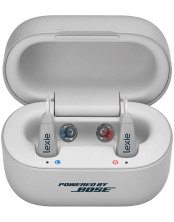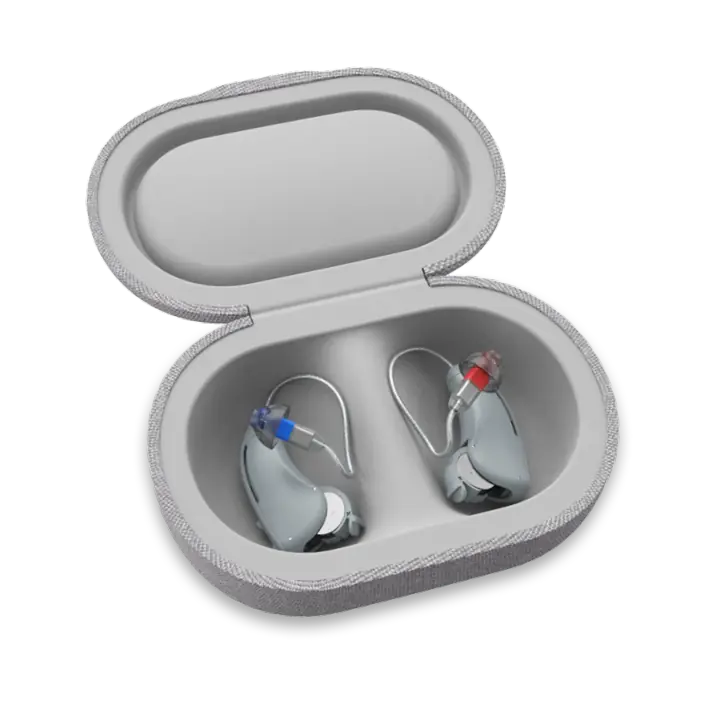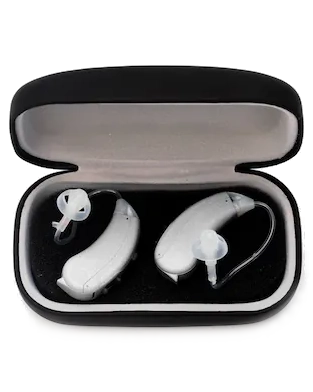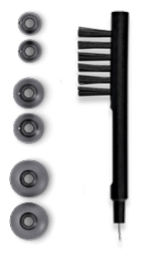Hearing Aid Parts | Important Terminology
Published: November 22, 2023
Updated: November 29, 2023
It can be intimidating to choose a hearing aid at first because there is a lot of information and terminology that you may find difficult to understand, and there are many options to choose from. This is a comprehensive list of hearing aid terminology, that is associated with hearing aids, that you should know.
Behind-the-ear (BTE)
This is a hearing aid that is placed behind the ear, such as Lexie OTC hearing aids, and is connected to a slim tube and dome, receiver-wire and dome, or an ear mold that is placed in the outer ear. A BTE that is connected with a slim tube and a dome can also be called an “open-fit”.
In-the-ear (ITE)
This hearing aid is fitted directly into the outer ear, and all the components are contained within the casing of the hearing aid.
Canal hearing aids
This device fits within the ear canal and, like the ITE hearing aids, all the components are contained within the casing of the device. There are two types of canal hearing aids:
- In the canal (ITC) – It fits in your ear canal
- Completely in the canal (CIC) – It’s fitted, and nearly hidden, in the ear canal
It is important to note that canal hearing aids are mainly used only for mild-to-moderate hearing loss.
Important terms
Microphone
The hearing aid microphone picks up sound from the surrounding environment and converts acoustic signals into electrical signals. There are 3 different microphones:
- Directional microphone – A directional microphone focuses on sound coming from in front of the hearing aid user and reduces the sound from behind and next to them. It is important to note that a directional microphone does not eliminate unwanted sounds, it only reduces the amplification of the sounds.
- Omnidirectional microphone – This microphone focuses on all sounds around the user. Sounds will be heard from in front, next to, and behind them.
- Adaptive microphone – This microphone automatically switches between a directional and omnidirectional microphone, depending on the listening environment.
Amplifier
The amplifier increases the strength (volume) of the electrical signal.
Receiver
The receiver converts the amplified electrical signal to an acoustic signal.
Important features
Gain – Gain is the amount of amplification that a hearing aid provides. An audiologist can determine how much gain your device will need based on your hearing loss.
Output – This is often referred to as the maximum power output (MPO). This is the maximum amount of amplification that the hearing aid can provide.
Programs – Programs adjust the way sound is processed to adapt to specific listening environments. Noisy environments, listening to music, listening through your cell phone, and windy environments are a few examples of different listening environments. A variety of these programs can be stored on the hearing aid and can be chosen by pushing a button on the device or remote control. Advanced hearing aids can analyze the sound environment and will automatically adjust accordingly.
Bands – Bands in hearing aids control the volume in a specific frequency range. Hearing aid bands divide the signal coming into the aid into frequency regions. This allows for the adjustment of specific frequency ranges (by adjusting the gain), according to the user’s hearing loss, and therefore, making the device unique to the user’s hearing loss.
Channels – Channels are a group of frequency bands that control a range of frequencies. The more channels a hearing aid has, the more it can be fine-tuned which allows for better personalization to the user’s hearing loss. Channels also allow the hearing aid to accurately analyze the sound environment so that it can differentiate between speech and noise-like sounds.
Feedback – Feedback is a high-pitched whistling sound that hearing aids produce when the microphone picks up the amplified sound from the receiver and amplifies it again creating a feedback loop and a whistling noise. Feedback can be caused by a damaged or poorly fitted ear mold, a crack in the tubing, wax blocking the ear canal, or when the volume is too high.
Feedback management/reduction – Feedback management reduces the feedback in the hearing aid by analyzing incoming signals and adjusting them immediately. It reduces feedback by minimizing the gain and through feedback cancellation. Feedback cancellation occurs when the hearing aid detects the feedback and immediately creates an identical signal in the opposite phase which cancels the signal out. This feature enables the hearing aid to maintain excellent sound quality.
Digital noise reduction (DNR) – This is a feature to make any speech signal in the presence of noise more comfortable while not reducing speech intelligibility. It manages to do this by separating the speech stimuli from the noise stimuli.
Frequency lowering – If you have severe to profound hearing loss in the high-frequency range, it is sometimes difficult to provide an appropriate amount of amplification to these frequencies. Therefore, frequency lowering can allow the hearing aid to shift these high-frequency sounds to a lower-frequency region where hearing is generally better. This feature may allow for a better understanding of speech as a lot of important speech content is in the higher frequencies.
There are three types of frequency lowering:
- Frequency transposition: Removes the high-frequency signal and shifts it to a lower-frequency region
- Frequency compression: Compresses high-frequency signal into a lower frequency region
- Frequency translation: Keeps the high-frequency signal, but also moves it down to a lower-frequency region
Sound generators or tinnitus maskers – This feature allows a hearing aid to produce internal sounds that can help reduce the perceived loudness of tinnitus that you may hear.
Data logging – A data logging system records the different listening environments that the hearing aid user is exposed to throughout the day. It is important because it can’t be determined in a hearing healthcare professional’s quiet office. It also allows the hearing aid to record how many hours a day it’s used, how often the volume is increased or decreased, and how often the user changes their hearing aid programs. The hearing healthcare professional can analyze and review this information and then make appropriate decisions regarding fine-tuning adjustments to the hearing aid and resolve certain types of difficulties the user might experience.
Hearing aid remote controls – Many hearing aids operate with a remote control to change the programs and the volume, without having to touch the device. The wearer can also make these adjustments to their aids by using a smartphone.






